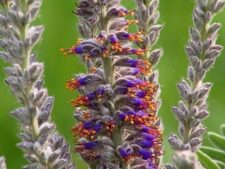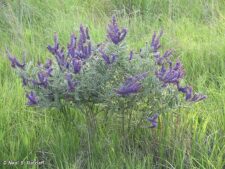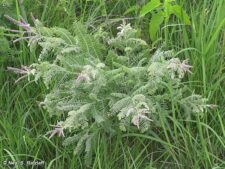
This native perennial shrub-like plant grows 1-3 feet tall, the older plants with woody stems (C). Roots may be as deep as 16 feet. The alternate, compound leaves have up to 24 pairs of opposite, elliptical leaflets plus a single one at the tip (D). Short, white hairs cover the leaves and stems giving the plant a silvery or leaden color, the origin of the common name (D). Unique, single-petaled, purple flowers with 10 protruding yellow stamens occur in densely packed, 2-4 inch clusters at the tips of the stems (A,B).
Grows on dry to moist, well-drained prairies, flowering in June and July. At Neale Woods, Lead Plant is common in the Knull & Jonas Prairie restorations.
Lead Plant is very palatable to livestock and decreases rapidly with grazing. Its presence in a prairie suggests it is in good condition. Stout, interlaced roots yielded grudgingly to the settler’s plow with a snap, earning it the name Prairie or Devil’s Shoestring. Leaves were dried and used to make “prairie tea.” Flowering time coincided with the bison rutting period prompting the Omaha and Ponca name of “buffalo bellow plant.”
The content of NatureSearch is provided by dedicated volunteer Naturalists of Fontenelle Forest who strive to provide the most accurate information available. Contributors of the images retain their copyrights. The point of contact for this page is: Neal Ratzlaff.



